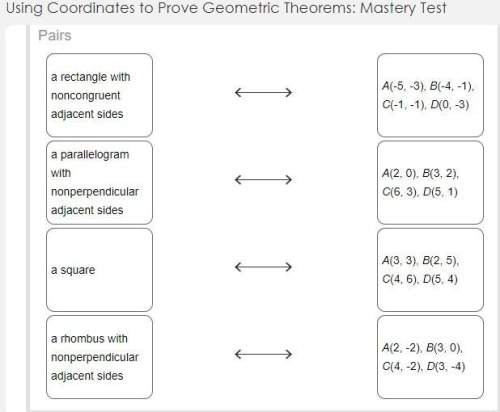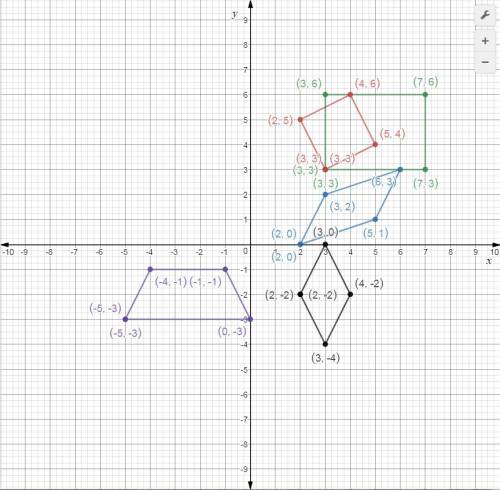
Mathematics, 17.07.2019 15:30 JEThompson6416
Match each set of vertices with the type of quadrilateral they form. tiles a(2, 0), b(3, 2), c(6, 3), d(5, 1) a parallelogram with nonperpendicular adjacent sides a(3, 3), b(3, 6), c(7, 6), d(7, 3) a rectangle with noncongruent adjacent sides a(-5, -3), b(-4, -1), c(-1, -1), d(0, -3) a square a(2, -2), b(3, 0), c(4, -2), d(3, -4) a rhombus with nonperpendicular adjacent sides a(3, 3), b(2, 5), c(4, 6), d(5, 4) i've shown the answers below in the screenshot


Answers: 1
Another question on Mathematics

Mathematics, 21.06.2019 15:30
Which equation represents the line that passes through the points and (4, 10) and (2, 7)? y = 3/2x - 11y = 3/2x +4y = - 3/2x + 19y = - 3/2x + 16
Answers: 2

Mathematics, 21.06.2019 17:30
Thelime contains the point(-3,0) and parallel x-3y=3( show all work)
Answers: 3

Mathematics, 21.06.2019 17:50
Graph y ≥ -x^2 - 1. click on the graph until the correct graph appears.
Answers: 1

Mathematics, 21.06.2019 18:30
F(x)=x^3+4 question 6 options: the parent function is shifted up 4 units the parent function is shifted down 4 units the parent function is shifted left 4 units the parent function is shifted right 4 units
Answers: 1
You know the right answer?
Match each set of vertices with the type of quadrilateral they form. tiles a(2, 0), b(3, 2), c(6, 3)...
Questions

English, 04.03.2021 01:00

Mathematics, 04.03.2021 01:00




Chemistry, 04.03.2021 01:00



History, 04.03.2021 01:00

Mathematics, 04.03.2021 01:00


Engineering, 04.03.2021 01:00

Advanced Placement (AP), 04.03.2021 01:00

Mathematics, 04.03.2021 01:00





Mathematics, 04.03.2021 01:00




